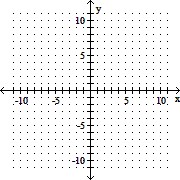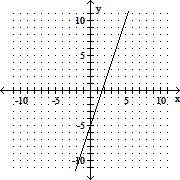Solve the problem.Looking ahead to retirement, you sign up for automatic savings in a fixed-income 401K plan that pays 6% per year compounded annually. You plan to invest $3000 at the end of each year for the next 25 years. How much will your account have in it at the end of 25 years? (Round to the nearest dollar.)
A. $164,594
B. $165,892
C. $166,364
D. $163,051
Answer: A
You might also like to view...
Sketch the line.-4x + 12y - 20 = 0
A. 
B. 
C. 
D. 
Factor out the greatest common factor.48m7 + 64m4 - 144m2
A. Prime polynomial B. 16(3m7 + 4m4 - 9m2) C. m2(48m5 + 64m2 - 144) D. 16m2(3m5 + 4m2 - 9)
Substitute the given values into the formula and then evaluate to find the unknown quantity. Label units in your answer. If the answer is not exact, round your answer to the nearest hundredth.Use the formula C =  (F - 32) to convert 14° F to degrees Celsius.
(F - 32) to convert 14° F to degrees Celsius.
A. 57.2° C B. -24.2° C C. -10° C D. 25.6° C
Find the zeros of the polynomial function. State whether the graph crosses the x-axis, or touches the x-axis and turns around, at each intercept. f(x) = -x2(x + 2)(x2 - 1)
A. x = 0, touches the x-axis and turns around; x = -2, crosses the x-axis; x = -1, crosses the x-axis; x = 1, crosses the x-axis B. x = 0, touches the x-axis and turns around; x = -2, crosses the x-axis; x = 1, touches the x-axis and turns around C. x = 0, touches the x-axis and turns around; x = 2, crosses the x-axis; x = -1, touches the x-axis and turns around; x = 1, touches the x-axis and turns around D. x = 0, crosses the x-axis; x = -2, crosses the x-axis; x = -1, crosses the x-axis; x = 1, crosses the x-axis